Remote Patient Monitoring in Queens

Reducing Hospital Readmission Rates in Queens
Amelia Home Care addresses avoidable readmissions by blending live 24/7 Professional Remote Care Coordination (RCC) with the latest intuitive remote patient monitoring.
Our team provides timely interventions, bridges external care services, and addresses patient psychosocial needs. RCCs collect and share patient data with the healthcare team, a key pillar in preventing avoidable readmissions.
With thousands of patients, Amelia Home Care is seeing a reduction in readmission rates of 91 to 95 percent.
Remote Care Coordination in Queens
Our Remote Care Coordinators (RCCs) provide face-to-face, video chat interactions with your patients to monitor and assist in adherence and reducing readmissions while improving clinical patient outcomes.
With the ability to visually record patient vitals, assess patient needs for medication refills, food, transportation to medical appointments, and social interactions, our coordinators develop personalized patient care with established protocols.
Available 24/7, RCCs cover the extended hours and weekends when staffing from Home Health is typically limited. Amelia Home Care patients thrive with more attention and interaction, and their satisfaction scores prove it!
Care Pathways for Queens Clients
Amelia Home Care has over 95 Care Pathways currently available to our clients including combination pathways for patients with multiple co-morbidities.
These pathways include branch logic and RCC protocol for follow-up questions. Our RCCs are trained to identify and report issues with post-acute and post-surgical patients, including the identification of SIRS criteria, which may lead to sepsis.
In addition to pathways questions, vital signs, and video conferencing, we have educational videos, teach-back questions, reminders, and the ability to assist patients in obtaining appointments, video-conferencing with family members, and other members of the care team.

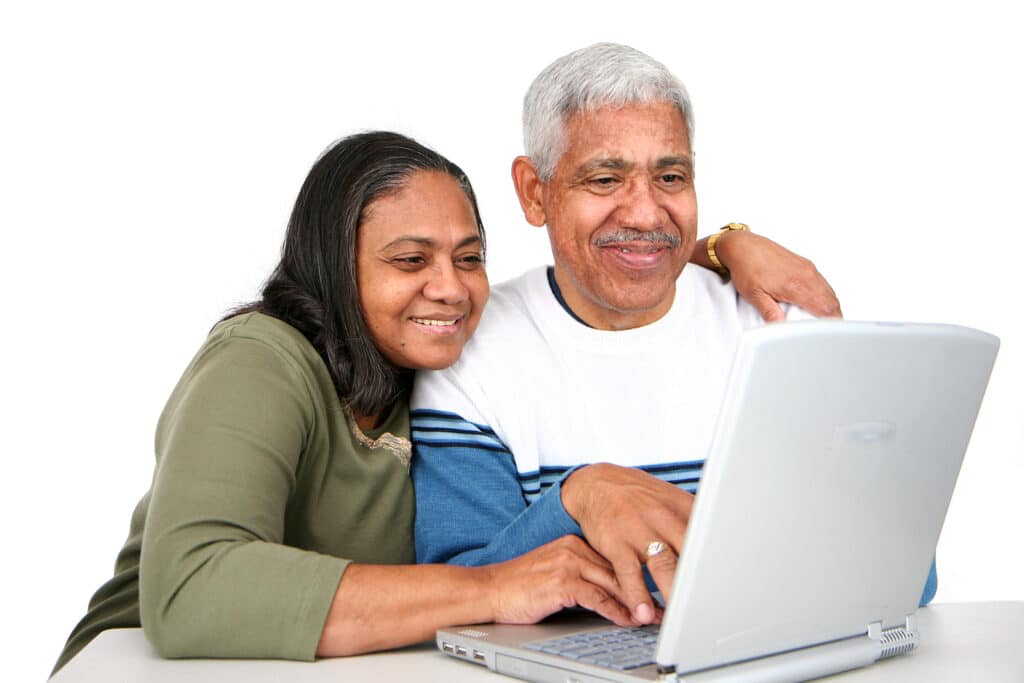
Psychosocial Needs and Socialization for Queens Residents
Often, many of our patients are seniors between 70 to 95 years old, and many are lonely and isolated. The RCC’s responsibility is to engage in casual conversations, beyond the illness and discuss life, and joyful matters.
For patients who require more attention, often receive multiple video calls per day and are assigned to volunteers to check in with the patients.
The results are astonishing, leading to reduction of readmissions, happier patient satisfaction, and increased RPM utilization rate.
Amelia Home Care Health Platform
Based on the patient’s capability and comfort level utilizing their preferred communication device, Amelia Home Care provides a variety of platforms to ensure as many patients are enrolled in the program as possible.
For patients accustomed to utilizing their own personal smartphone or tablet (Apple or Android), an easy-to-download application is provided.
A telehealth kit, which consists of a tablet with built-in internet and wireless medical devices and is intuitive to operate, can be delivered to the patient’s home.
If both are not viable options, their assigned RCC can render phone calls to retrieve ongoing data collection so no patient is left out of the program.
Authorized physicians, nurses, nursing staff, and Home Health agencies will have access to patient data and telehealth communication with the patient based on their security access privileges.
Oftentimes, physicians and nurses find it more convenient to work with the assigned RCC.
Based on schedule or ad hoc calls, the RCC can engage the physician on a group video conference with the patient by sending a link to the physician’s email or phone.
Upon clicking the link, the physician will be able to join the secured video conference call with the patient.
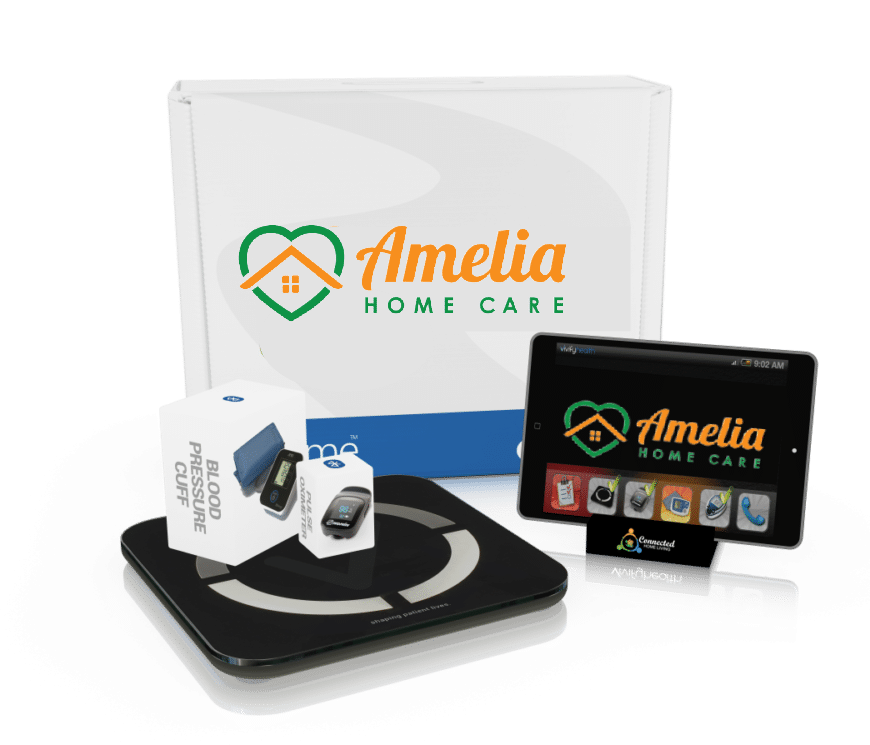
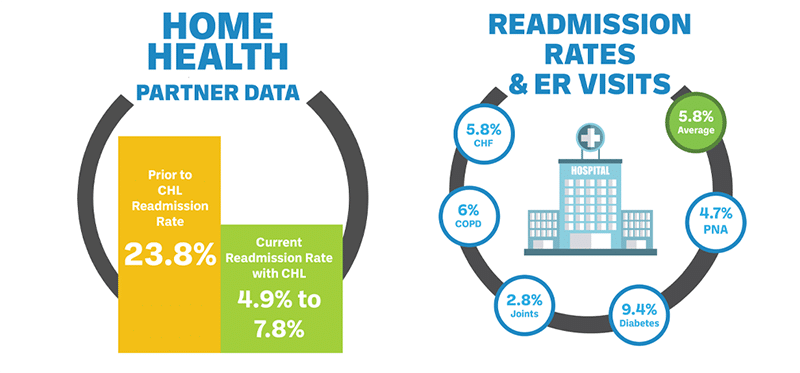
How We Help Hospitals and Health Systems in Queens
TURN-KEY communication center for efficient coordination of care – no implementation or set up fee.
FACILITATE safe return to home – enabling shorter hospital length of stay.
REDUCE unnecessary hospital readmissions.
ENABLE the efficient and streamlined monitoring of post-acute care.
MANAGE the volume of incoming data based upon clinically defined thresholds.
COLLECT clinically meaningful data to enhance and adjust care.
SUPPORT client/patient autonomy through education and communication.
ENHANCE resource management to ensure clinical visits are necessary, with documented justification.
DRIVE value-based care by increasing and enhancing ongoing interactions between patients and clinicians.
DEFINE the standard of care in the marketplace.
How We Help Physician Groups in Queens
- TURN-KEY remote monitoring communication center for efficient coordination of care.
- FACILITATES ease of access to patient data.
- MANAGES the volume of incoming data based upon clinically defined thresholds.
- COLLECT clinically meaningful data to enhance and adjust care.
- SUPPORT the delivery of higher quality care to more patients.
- REDUCE unnecessary hospital readmissions.
- ENABLE the efficient and streamlined monitoring of post-acute care.
- SUPPORT client/patient autonomy through education and communication.
- ENHANCE resource management to ensure clinical visits are necessary, with documented justification.
- POSITION practice for the value-based care market by increasing ongoing interactions between patients and clinicians.
- DEFINE the standard of care in the marketplace.
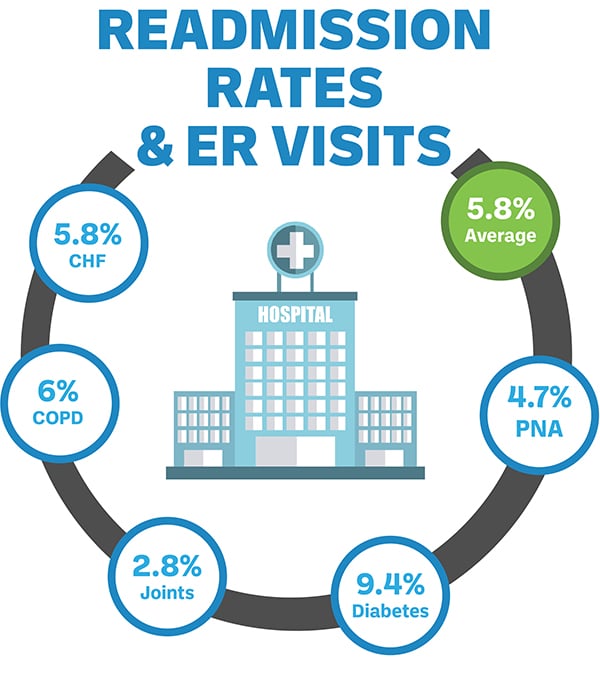

How We Help Accountable Care Organizations Who Serve Queens
- CHRONIC CARE management supporting a reduction in Medicare costs.
- IMPROVED communication channels between multiple providers and specialists.
- ENABLE enhanced care coordination throughout the medical care continuum.
- REDUCE unnecessary and redundant healthcare service.
- FACILITATE your ability to meet CMS standards for cost savings.
- COLLECT clinically meaningful data to enhance and adjust care.
- SUPPORT client/patient autonomy through education and communication.
- ENHANCE resource management to ensure clinical visits are necessary, with documented justification.
- DRIVE value-based care by increasing and enhancing ongoing interactions between patients and clinicians.
- ENGAGE patients in their care and drive patient centricity.
Programs and Plans

Amelia's Tele-Home Care Family Pack for Queens Residents
How Does Virtual Caregiving Work?
- Sign-up loved ones based on their needs and technological ability using a smartphone, tablet, computer or landline
- Amelia Home Care develops a care plan and trains your loved ones to use our telehealth solution
- Daily Health Surveys monitor your health
- Live Remote Care Coordinators (RCCs) evaluate your needs and provide support
- RCCs escalate issues to a Family Member or Nurse, based on pre-defined protocols
- Nurse or Physicians may assess and treat patient using video triage*
- RCC can coordinate medication, food, and supplies
Are you ready for an Amelia Home Care Certified Technologist to install and train your family to be connected and safe. With Amelia’s Tele-Home Care Family Pack, Seniors can live independently longer, safe from falls and other common concerns.
There’s an emergency button to request help at anytime, and also activity sensors that will detect hazards and call for help when it’s need.
Seniors can live independent longer, safe from falls and other common concerns, with Amelia’s Tele-Home Care Family Pack.
There’s an emergency button to request help at anytime, and also activity sensors that will detect hazards and call for help when it’s need.
Best of all, caregivers can check in anytime – without disturbing the senior or invading their privacy.
How Does Amelia’s Tele-Home Care Family PackWork?
Amelia Home Care is a Certified Technologist that Installs and Trains for You!
Install The Family Pack.
A personal assist button, front and back door entry sensors, and motion sensors for the Kitchen, Hallway, and Living Room are easy to install. It includes everything you need to address concerns of falls, wellness, and loneliness in a new collaborative way. Installation is fast and simple.
The activities of daily living are learned.
The normal lifestyle patterns of the senior are privately learned, without a wearable, and insights can be accessed by members of your Trusted Circle of friends and family.
Smart Home Center
This makes your home intelligent. Simply plug it in to power and plug in a wired internet connection. The free app will walk you through the whole process.
Personal Assist Button
Push it at any time to alert the people in your Trusted Circle and let them know that assistance is needed. Or change its behavior to record access to medication.
Front Door and Back Door Entry Sensors
They attach to a home’s high-traffic doors in just minutes so you can know when someone comes and goes. Install extras on medicine cabinets, refrigerators, and microwaves.
Kitchen, Hallway, and Living Room Motion Sensors
They alert for potential falls, sleep problems, and more. We recommend one motion sensor every 500 square feet of living space, so the base pack covers about 1,500 square feet.
Professional Monitoring. 24/7.
When lifestyle patterns change unexpectedly, automatically alert your Trusted Circle and the Emergency Call Center to get help fast.
The Amelia Home Care Trusted Circle
This intelligent system uses easy to install wireless sensors around the home (no cameras) to learn daily activity patterns and alerts family, professional caregivers, and emergency services (if necessary) of falls and potential hazards even if the emergency button is out of reach.
The Trusted Circle is an exclusive group of contacts who care for the wellbeing of a friend or loved one using Amelia Home Care Family in their home.
Trusted Circle contacts receive Group SMS Notifications and In-App Push Notifications to actively participate and immediately respond to falls and other potential hazards or simply stay in the know. Contacts can also use the Amelia Home Care Family app to get real-time wellness status updates, daily reports, and more.
Join the Trusted Circle
- You will receive a text message invitation from Amelia Home Care.
- Click on the provided link, download the Amelia Home Care app, and follow the instructions to setup your Amelia Home Care account.
- Add the Amelia Care Family Emergency Call Center phone number to your contact list for safekeeping. Unknown numbers are often considered SPAM so it’s best to be ready to help when called upon


How it Works
This intelligent system uses easy to install wireless sensors around the home (no cameras) to learn daily activity patterns and alerts family, professional caregivers, and emergency services (if necessary) of falls and potential hazards even if the emergency button is out of reach.

Know that everything is okay. Get real-time wellness status updates, daily reports, and more.
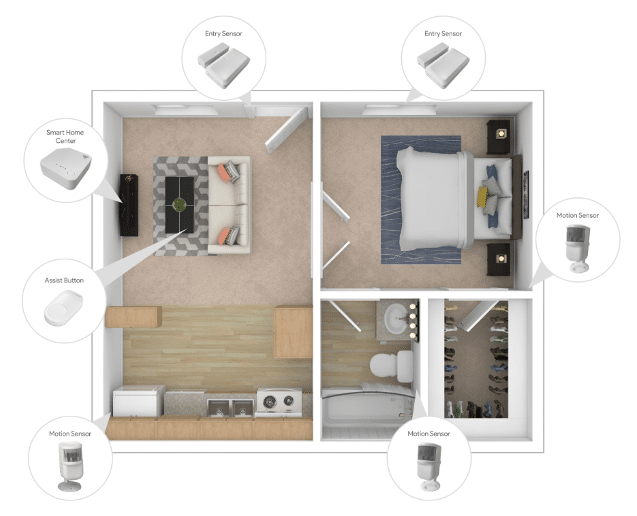
Monitors the home 24/7 including fall detection, failure to return, sleep monitoring, and more.
When problems arise, Amelia Home Care Family communicates outward in a tiered escalation methodology as urgency increases. This approach gives family and professional caregivers an opportunity to get involved and deescalate issues before dispatching Emergency Services.

Get alerted and know what’s happening.
Get involved right away to help resolve the issue.
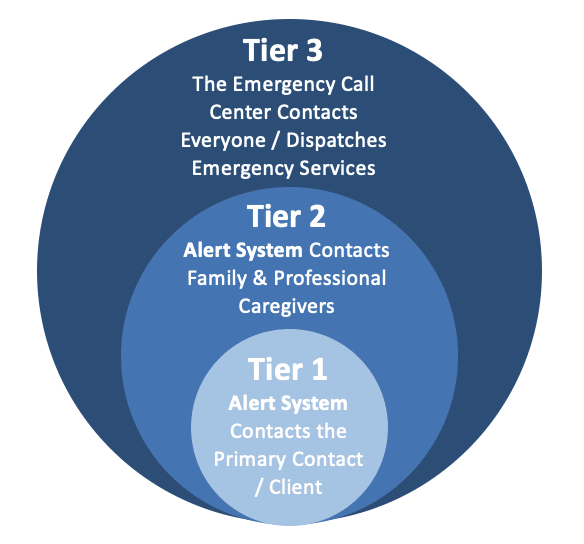
Group SMS Notifications, In-App Push Notifications,
24/7 Call Center, & Emergency Services
Features for Every Lifestyle
Captures and describes lifestyle patterns into the app
- Check-in remotely, review the Daily Report, and know where people were last seen.
- Detects when people are home, away, or sleeping.
- Record access to medication with a variety of medication activity sensors.
Measures sleep quality with an activity sensor in the bedroom. - Track trips to the bathroom, showers, and bathroom falls with a bathroom motion sensor.
- Identifies meal activities with access to the microwave, coffee, and fridge.
Alerts when problems are detected
- Fall detection without a button: alerts on unexpected inactivity in the home.
- Medical alert button to call for emergency help or simply request assistance.
- Alert if occupants do not get up in the morning.
- Notify if occupants did not make it to the bedroom at night.
- Detect if the stove is left on, unattended.
- Delivers reminders if people forgot to take medication.
- Mold and mildew detection with added humidity sensors.
- Integrates fall and SOS alerts from Apple Watch and Samsung Galaxy Watch.
- Uses text messages for alerts, so family participants don’t have to download an app.
Proven to help fight senior depression, loneliness, and isolation
- Coordinates and assigns a new family member to reach out each day, with suggestions on what to talk about from the last person.
- Smart Speaker support to control the home, play music, and connect family.
Adds needed support for Dementia and Alzheimer’s
- Alerts when perimeter doors open to detect wandering.
- Predicts when occupants should arrive back home, and alerts if they’re not.
- Pings your phone if someone is caught roaming around the house at night.
- Water leak detection for the bathroom and toilet.
Expandable
- Apple Watch and Samsung Galaxy Watch keep track of falls.
- Amazon Alexa and Google Home integrate to control with your voice.
- Smart Locks secure the home and provide access to the Trusted Circle.
- Smart Bulbs and Plugs to control lighting and appliances with your voice.
- Connected Thermostats integrate to control comfort and save energy.
- Security system enabled with a siren and keypad helps seniors feel in control.
About Queens
Queens is a borough of New York City, coextensive with Queens County, in the U.S. state of New York. It is the largest borough of New York City in area and is adjacent to the borough of Brooklyn at the western end of Long Island,[5] with Nassau County to the east. Queens also shares water borders with the boroughs of Manhattan, the Bronx, and Staten Island (via the Rockaways).
Queens is the second-largest in population of the five New York City boroughs with a population of 2,230,722 as of the last official U.S census count in 2010.[3] If each borough were ranked as a city, Queens would rank as the fifth-most-populous in the U.S., after Los Angeles, Chicago, Brooklyn, and Houston.[5] Approximately 47 percent of the residents of Queens are foreign-born.[3] Queens County also is the second-most-populous county in New York State, behind Kings County. Queens is the most linguistically diverse place on Earth and is one of the most ethnically diverse counties in the United States.[6][7][8]
Queens was established in 1683 as one of the original 12 counties of the Province of New York. The settlement was presumably named for the English Queen Catherine of Braganza (1638–1705).[9] From 1683 to 1899, the County of Queens included what is now Nassau County. Queens became a borough during the consolidation of New York City in 1898, combining the separate towns of Long Island City, Newtown, Flushing, Jamaica, and western Hempstead.[10] With the exception of Hempstead, all are today considered neighborhoods of Queens.
Queens has the most diversified economy of the five boroughs of New York City.[11] It is home to two of New York City’s airports: John F. Kennedy International Airport and LaGuardia Airport. Landmarks in Queens which support its economy include Flushing Meadows–Corona Park; Citi Field, home to the New York Mets baseball team; the USTA Billie Jean King National Tennis Center, site of the U.S. Open tennis tournament; Kaufman Astoria Studios; Silvercup Studios; and the Aqueduct Racetrack. Flushing is undergoing rapid gentrification with investment by Chinese transnational entities,[12] while Long Island City is undergoing gentrification secondary to its proximity across the East River from Manhattan.
The borough has diverse housing, ranging from high-rise apartment buildings in some areas of western and central Queens, such as Ozone Park, Jackson Heights, Flushing, Astoria, and Long Island City, to neighborhoods with many low-rise structures in the eastern part of the borough.[13][14] The Queens Night Market in Flushing Meadows-Corona Park attracts thousands nightly to sample food from dozens of countries.[15]
The Unisphere is a spherical stainless steel representation of the Earth in Flushing Meadows–Corona Park in the New York City borough of Queens. The globe was designed by Gilmore D. Clarke as part of his plan for the 1964 New York World’s Fair. Commissioned to celebrate the beginning of the space age, the Unisphere was conceived and constructed as the theme symbol of the World’s Fair. The theme of the World’s Fair was “Peace Through Understanding” and the Unisphere represented the theme of global interdependence, being dedicated to “Man’s Achievements on a Shrinking Globe in an Expanding Universe”.
The Unisphere measures 140 feet (43 m) high and 120 feet (37 m) in diameter. It sits atop a 20-foot-tall (6.1 m) tripod base with over 500 steel pieces representing the continents, as well as three steel rings representing the first artificial satellites orbiting Earth. Around the Unisphere is a reflecting pool measuring 310 feet (94 m) in diameter. The base is surrounded by 48 pairs of fountainheads, which were intended to conceal the tripod supporting the globe.
Clarke devised plans for the Unisphere while aboard an airplane in 1960. New York City parks commissioner Robert Moses, who had already rejected two plans for iconic structures at the 1964 Fair, approved Clarke’s proposal in early 1961. After further refinements, the Unisphere was constructed by American Bridge Company, a division of U.S. Steel, from March to August 1963. Over 51 million people visited the Unisphere during the World’s Fair, after which it became a permanent attraction of Flushing Meadows–Corona Park. The Unisphere fell into disrepair in the 1970s and was restored in the early 1990s. The Unisphere was made a New York City designated landmark in 1995 and, after another period of disrepair, it was restored in the early 2010s.
Many public figures have grown up or lived in Queens.[180] Musicians raised in the borough include The Ramones, Nas, LL Cool J, A Tribe Called Quest, Mobb Deep, Onyx, Ja Rule, 50 Cent, Lloyd Banks, Tony Yayo, Run–D.M.C., Nicki Minaj, Lil Tecca, Rich The Kid, Tony Yayo, Action Bronson, Nadia Ali[181] and Tony Bennett.[182] Jazz greats Louis Armstrong and Norman Mapp both resided in Corona, as well as rock duo Simon & Garfunkel[183] and guitarists Scott Ian and Johnny Ramone.[184] K-pop rapper Mark Lee from the boy group NCT grew up in Queens before moving to Canada. Actors such as Adrien Brody,[185] Zoe Saldana, Lucy Liu,[186] John Leguizamo, Susan Sarandon, and Idina Menzel[187] were born or raised in Queens. Actress Mae West also lived in Queens.[188] Writers from Queens include John Guare (The House of Blue Leaves) and Laura Z. Hobson (Gentleman’s Agreement). Physician Joshua Prager was born in Whitestone.[189] Mafia boss John Gotti lived in Queens for many years.[190] Richard Feynman, a scientist who was awarded the Nobel Prize in Physics, was born in Queens and grew up in Far Rockaway. Lee “Q” O’Denat, founder of WorldStarHipHop was from Hollis, Queens.
Donald Trump, a businessman who became the 45th President of the United States, was born in Jamaica Hospital Medical Center and raised at 81-15 Wareham Place in Jamaica Estates, later moving to Midland Parkway.[191][192][193] He was preceded in the White House by former First Ladies Nancy Reagan, who lived in Flushing as a child.[194] Theodore Roosevelt, the 26th President, lived at Sagamore Hill in Oyster Bay from the mid-1880s until he died;[195] the area was considered part of Queens until the formation of neighboring Nassau County in 1899. Queens has also been home to athletes such as professional basketball player Rafer Alston[196] Basketball players Kareem Abdul-Jabbar[197][198] and Metta World Peace[199][200] were both born in Queens, as was Olympic athlete Bob Beamon.[201] Tennis star John McEnroe[202] was born in Douglaston. Hall of Fame baseball pitcher Whitey Ford grew up in Astoria.[203] Journalist Marie Colvin was a native of Queens.
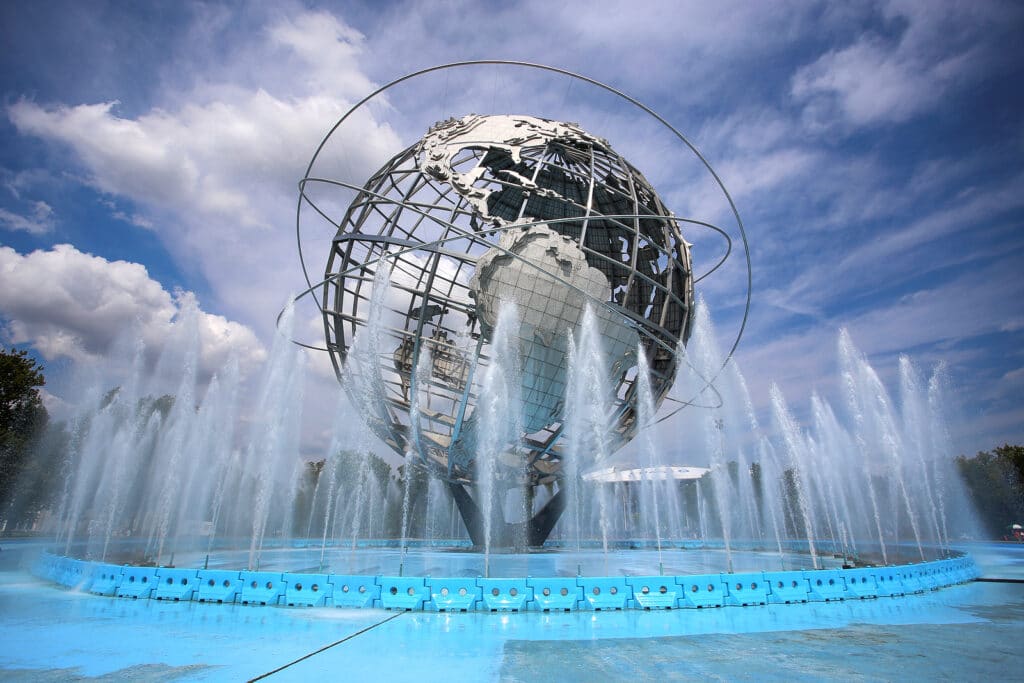
Map of Queens
Map of Directions from Queens to Amelia Home Care
Driving Direction from Queens to Amelia Home Care
Queens, New York
Get on I-678 S from Union Tpke and Main St
12 min (2.6 mi)
Head south on 175th St toward 75th Ave
0.2 mi
Turn right onto Union Tpke
Pass by Popeyes Louisiana Kitchen (on the right in 0.5 mi)
1.3 mi
Turn left onto Main St
0.4 mi
Slight right to stay on Main St
0.2 mi
Turn right onto Queens Blvd
331 ft
Turn left to stay on Queens Blvd
141 ft
Queens Blvd turns slightly left and becomes Van Wyck Expy
0.1 mi
Merge onto I-678 S via the ramp on the left to Kennedy Airport
0.3 mi
Continue on I-678 S to N Conduit Ave. Take exit 1W from I-678 S
5 min (2.8 mi)
Merge onto I-678 S
2.3 mi
Take exit 1W toward Belt Pkwy W
0.5 mi
Get on Belt Pkwy
3 min (1.2 mi)
Slight right onto N Conduit Ave
1.0 mi
Slight left onto the Belt Pkwy W ramp to Verrazano Bridge
0.2 mi
Follow Belt Pkwy to Shore Pkwy in Brooklyn. Take exit 7B from Belt Pkwy
13 min (10.6 mi)
Merge onto Belt Pkwy
10.5 mi
Take exit 7B toward Ocean Pkwy
0.1 mi
Continue on Shore Pkwy. Take Ocean Pkwy to Ocean Parkway Service Rd
8 min (1.2 mi)
Continue onto Shore Pkwy
0.2 mi
Turn left onto Ocean Parkway Service Rd
0.1 mi
Slight left onto Ocean Pkwy
0.3 mi
Turn left onto Ocean View Ave
0.1 mi
Turn right onto Brighton 2nd St
0.1 mi
Turn right onto Brighton Beach Ave
0.2 mi
Turn right onto Ocean Parkway Service Rd
Destination will be on the right
0.1 mi
3007 Ocean Pkwy
Brooklyn, NY 11235